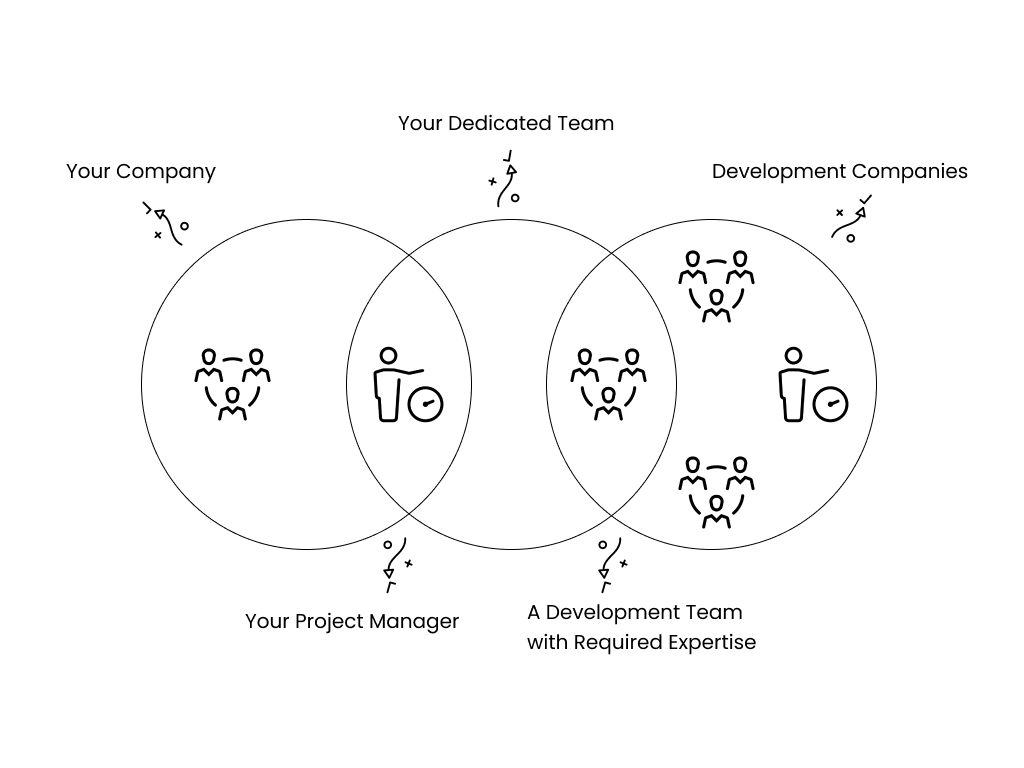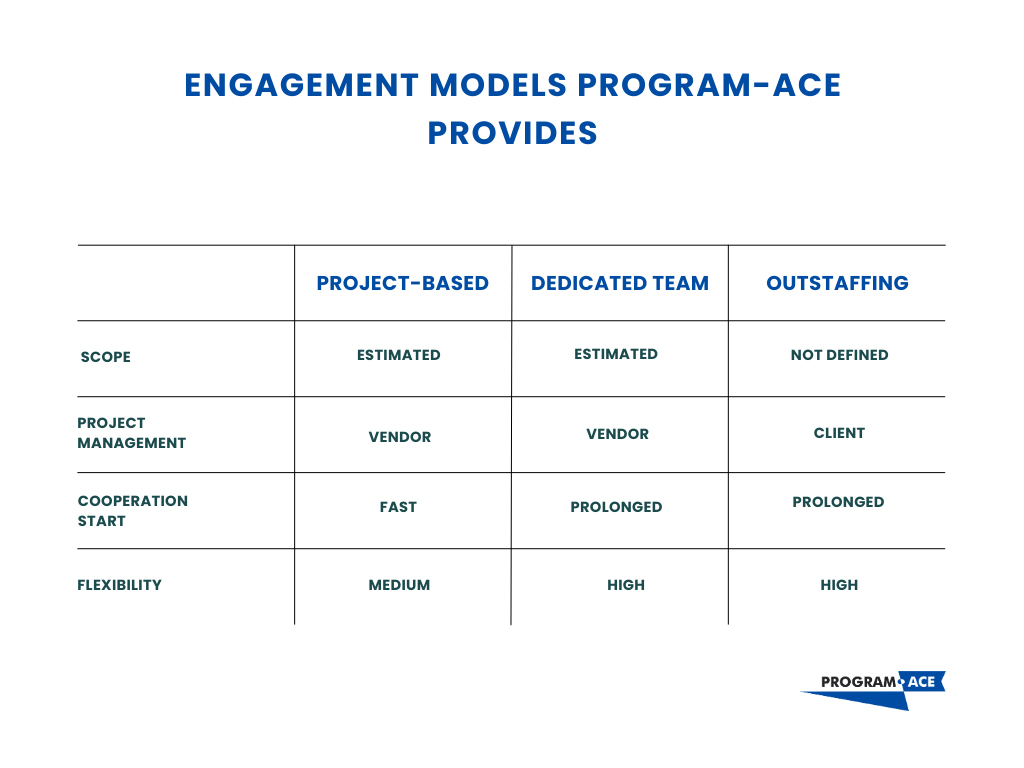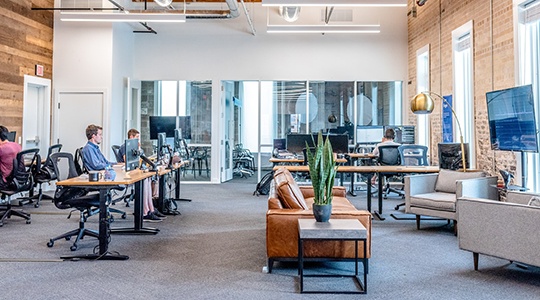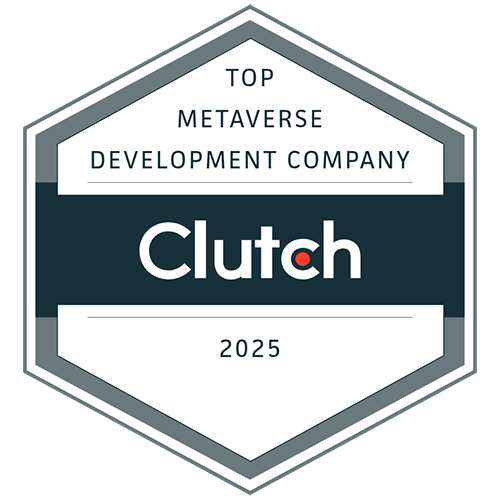IT outsourcing has become a common practice for businesses of any size and industry: for example, around 90% of G2000 companies outsource some of their IT operations to third-party vendors. The range of outsourcing services is huge, allowing enterprises to leverage external expertise to solve their critical problems. At the same time, the variety of technical challenges companies face pushes IT vendors to come up with different engagement models and cater more precisely to the specific needs of every client.
Software development is one of the most popular requests businesses have. When a client comes to a software development outsourcing company, they usually encounter several options on how to cooperate with a vendor. So how to choose an engagement model for software development that will suit your business? This article will help you find an answer to this question and comprehend better the alternatives that your company has.
What is an Engagement Model?
In software development outsourcing, an engagement model definition stands for a framework that determines the relationship between the client and the vendor during their cooperation. Over the years, the industry has come up with a range of engagement models that have become a common standard adopted by software outsourcing vendors. Of course, every company adjusts the details of a particular model according to its capabilities and specifics, but in general, the majority of vendors use the same system of engagement models when offering their services.
Engagement models for software development services define the next aspects of vendor-client collaboration, as responsibilities, obligations, standards of execution, control, accountability, flexibility, ownership, and terms of project implementation — basically everything that establish the level of vendors’ involvement and allocate responsibility between parties.
Software development services imply a wide set of initiatives, and every company’s needs differ in terms of what gap in their internal expertise or resources they want to fill.
Therefore, it’s almost impossible to reduce software outsourcing merely to the point where a vendor just gets a confirmation of cooperation and gets to work. To ensure that a client is satisfied with the services provided and that delivered solutions are up to superior quality, vendors leverage engagement models. They allow for generating more value for customers, as well as clarify the cooperation conditions at the very beginning and set correct expectations of collaboration.

Different Types of Engagement Models
The list of engagement models is pretty extensive, and this variety allows businesses to choose the most comfortable type of partnership. We gathered the most common engagement model examples to help you find the most suitable one for you.
Time & Material Model
Time & material is one of the most popular models you can find on the market of software development services. It is often opposed to fixed-budget contracts, which suggest that a price for software solution development is determined from the start and won’t change. In turn, the time & material model implies that a client is paying only for the work done at an hourly rate.
The time & material model will be a good fit for companies conducting long-term development projects with unclear scope and dynamic conditions. At the same time, to get a proper result, a client needs to invest their time and efforts in cooperation, engage in development planning and synchronize with a vendor for a common goal vision.
Pros of the T&M model:
enhanced flexibility and ability to implement changes to the project scope without losing money;
high level of control over the project's progress and decision-making;
an opportunity to shape software requirements along the way and with the help of industry experts.
Cons of the T&M model:
low budget planning, as you can’t predict the final price of the solution;
high level of vendor involvement and the need for constant communication with a vendor;
unclear deadlines, as the timeline and scope aren’t definitely established.
Dedicated Team (Outsourcing)
A dedicated team is a model when an outsourcing company provides a specialized development team exclusively focused on your project. Within it, the selection of software developers is based on the specific requirements of the client and they are managed directly from the outsourcing company side. A client pays a monthly fee that covers compensations for the full-time team members as well as a vendor’s fee for administrative expenses.

Dedicated software development teams can include various specialists, namely front- and back-end developers, UI/UX designers, 3D artists, QA specialists, DevOps engineers, business analysts, project managers, etc. A service provider can pick up the necessary people from their pool or recruit new ones for you and supplement the team with the required expertise. In the dedicated team model, the client doesn't recruit the necessary specialists, as this responsibility goes to the selected outsourcing partner. Your vendor might already have a talent pool they can onboard to your project, or they start hiring and interviewing potential employees on the client's behalf.
The dedicated team model is typically suitable for long-term projects or ongoing development needs and entails the service provider taking on the responsibility of project management and all administrative issues, eliminating the need for hands-on management by the client.
Pros of the dedicated team model:
stable and predictable budgeting;
high speed of software development life cycle, as the team fully focused on your project;
high level of control over project management and progress.
Cons of the dedicated team:
prolonged project start, as the vendor might need time to staff a team accordingly to the client’s needs;
not applicable for short-term projects;
the client needs to have a detailed vision of its final software product to get the maximum value.
For example, Program-Ace has a pool of 120+ experts across a wide range of skills and competencies. This wealth of expertise enables us to create dedicated development teams that are precisely tailored to meet the unique requirements of our clients.
Outstaffing Model
Outstaffing, also sometimes called staff augmentation, is the model that allows businesses to quickly expand their team with necessary specialists through cooperation with a vendor. Instead of going through the traditional hiring process, a company can sign up for an outstaffing contract with a software service provider and onboard outstaffed specialists into its in-house team.
In the outstaffing model, tech specialists work as full-time employees on a client’s project, while being employed by a vendor. The latter takes care of administrative aspects of developers’ employment, like compensations, benefits, equipment, etc., while a client only pays an agreed-upon fee. The outstaffing contract can be valid for any period and will be a great aid to companies that need to onboard specific tech experts into their team as soon as possible.
Pros of the outstaffing model:
quick scale-up or scale-down of your in-house development team;
access to a wide range of specialists with different industry and technology knowledge;
full control over the outstaffed developers’ work and an opportunity to manage them on your side.
Cons of the outstaffing model:
language and cultural barriers in case of hiring specialists from other countries;
high level of responsibility for the success of cooperation;
the challenges of remote work, namely the difference in time zones between your in-house team and outstaffed specialists.
In an outstaffing model, the client has full control over the team's composition, roles, responsibilities, and project priorities. The outstaffed software developers are under your direct supervision, and it is your responsibility to use their skills to suit your business goals best.
Hybrid Onshore-Offshore Model
While researching the phenomena of outsourcing, you can encounter terms like onshoring (outsourcing to a company located in the same country as a client), nearshoring (outsourcing to a company located in a neighboring country), and offshoring (outsourcing to a company located in a distant country). Every option has its upsides and downsides, but the IT industry has come up with a hybrid onshore-offshore model which minimizes the disadvantages and generates the most value.
This vendor engagement model works the next way: a service provider handles strategic tasks and management onshore, whether by posting its employees to the client’s site or from their onshore location. In this manner, a vendor helps its client to identify requirements and build a plan on how to cater to clients’ needs. Then, the development process goes to the offshore part of the vendors’ team, thereby optimizing expenses.
Pros of the hybrid onshore-offshore model:
smooth and reliable communication with a vendor;
a perfect balance between cultural fit and cost optimization;
higher software quality and faster time-to-market.
Cons of the hybrid onshore-offshore model:
increased need for a reliable partner with strong management capabilities.
What Engagement Models does Program-Ace Recommend?
Program-Ace strives for providing a superior customer experience and helping our clients reach their goals through custom software development. Therefore, we offer several business engagement models that allow us to cater more precisely to the unique requirements our clients have.
Project-based model: you have defined the requirements or scope of your project, and we provide you with a development team to implement this part of the work.
Dedicated team model: we assemble a team of hand-picked developers and other tech specialists who dive into your project on a high level, while you remain in control over the team's capacity, project management, working hours, and deadlines.
Outstaffing model: we provide you with required tech specialists who join your in-house development team as full-fledged team members to fill the expertise gaps you have.

Program-Ace Approach to the Engagement Process
As a leading custom software development company with decades of experience, we know how to establish cooperation to deliver maximal value to the client. Our wide industry and technology expertise allow us to suggest the most suitable tech stack for your project, as well as tailor the development process to the specifics of your business and your development.
Contact us to initiate a partnership and strengthen your business with the help of our technical expertise. Our managers are ready to provide you with the necessary info on the variety of engagement models we offer.
FAQ
There are dozens of available engagement models on the market, all for different purposes. To select a suitable model for your project, you need to evaluate various factors that will determine the nature of your relationship with your vendor. Here are a few actions you can take to understand what model will suit you:
- identify your project requirements, objectives, and desired outcomes;
- evaluate the complexity of your project;
- estimate what tech expertise you have in-house and what gaps you need to fill with outside contributions;
- determine the level of flexibility you require in terms of scope changes, timeline, and budgeting;
- decide what level of control you want to have over the development process.
When you map out answers to these questions, you will have a vision of what help you need and what level of engagement should be provided. Then, you can proceed to research various engagement models and select the one that will match your requirements the best.
At the same time, if you struggle to figure out the specifics of your project by yourself, you can always consult with a service provider that will help you navigate the variety of models. Usually, vendors will briefly interview you to understand what outcome you want to get and then suggest a few options and explain how they will be beneficial for your case.
Outstaffing is an engagement model that implies that a business hires vendors' developers into its in-house team. A client's side remains responsible for project progress and developers' management, while outstaffed developers work with the same level of engagement as regular in-house employees. In turn, a vendor takes care of administrative aspects of outstaffed developers' employment, e.g., compensation, equipment, benefits, etc. A client only pays a fee that covers developers' salaries and administrative overhead.
The dedicated team development model implies that a vendor assembles a full-fledged development team that focuses on a client's project in full. Dedicated developers contribute their skills and expertise to turn a client's vision into reality. A dedicated team might consist of various specialists, namely front- and back-end developers, QA engineers, UI/UX designers, business analysts, DevOps, etc. A client pays a stable monthly fee that covers the engagement of a dedicated team, whether the scope or requirements change during the development process.
As you can see, these two models are totally different and leverage different approaches to vendor-client cooperation and the development process itself. Outstaffing will be a good match for businesses that have a strong in-house tech team but lack several certain experts and don't want to go through the traditional hiring process. A dedicated team will suit those that plan to start a long-term development process but don't have a full-fledged development team in-house.
Therefore, it is hard to say if one model is better than the other, as they provide solutions for two different challenges and consequently for two different cases.
Both time & material and fixed price models have their ups and downsides, and for different projects, the weight of their advantages and disadvantages will vary.
In a fixed-price model, a client pays an agreed-upon price for a development project. This price is based on previously determined requirements and deliverables. The benefit here is that the price is stable and predictable. However, it is also a catch: if suddenly there is a need to make a change in requirements or work scope, it will bring additional expenses and complicate the development process.
In a time & material model, a client pays for services at an hourly rate for the work done. Requirements can be unstable and constantly change, and a customer won't spend extra to implement any change that needs to be included. However, at the same time, a client can not really predict the final budget spent on the development, which possesses its own challenges.
So, the T&M model will show the most efficiency for projects with unclear or unstable requirements, where the scope can change during the development, while the fixed price model will work best for rather small projects with 100% definite scope.
We can not give a definite answer to this question, as the cost-effectiveness of a certain model will depend on the project specifics, namely software requirements, scope, and complexity of work, availability of tech experts on the client side, etc. Hence, if you are in the middle of selecting an engagement model, evaluate your project from different sides and study the ups and downs of available models on the market.
However, if to generalize, we would suggest the next models for these types of projects:
- for small ones with well-defined requirements and short ones — fixed price model, as it provides predictable cost and in case there are no changes to the scope, won't bring any additional expenses;
- for larger projects with modifying or unclear requirements — time and material model, as it gives necessary flexibility to adjust software development to ever-changing conditions, recent user feedback, etc., and helps to avoid overruns and delays;
- for cases when one or two additional specialists are needed — outstaffing, as it allows to quickly onboard necessary specialists into the already assembled team without spending resources required for traditional hiring;
- for large projects with huge scopes and limited budgets — dedicated team, as it allows predicting the monthly budget necessary for the team support, as well as ensuring the full involvement of the first-rate specialists in the project.
It is hard to determine what model possesses less risk for software development, as the risk levels are very individual to each project and depend on its specifics. So, while one model can only increase the risk for a certain project, the other one can mitigate the majority of threats easily.
Fixed-price (FP) engagement models typically carry more risk for software delivery as they require a well-defined scope and specifications upfront, which can be challenging for complex software projects. Changes to the scope or requirements may result in additional costs or delays, and the delivery timeline is usually fixed, which can make it difficult to accommodate changes.
On the other hand, time and material (T&M) engagement models provide more flexibility in project scope and requirements, making it easier to manage risks associated with changes or unexpected challenges during software delivery. T&M models typically have a more transparent billing process, allowing for better tracking of costs and expenses.
Additionally, hybrid engagement models that combine the benefits of FP and T&M can be used to manage risk in software delivery. For example, using a fixed-price model for a well-defined project phase and a time and material model for more flexible phases can help manage risks while still providing cost predictability.























